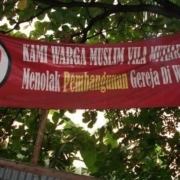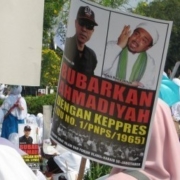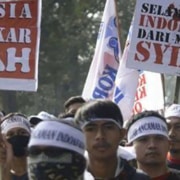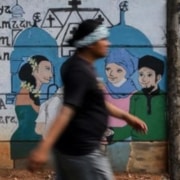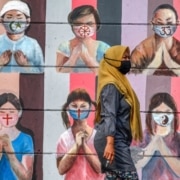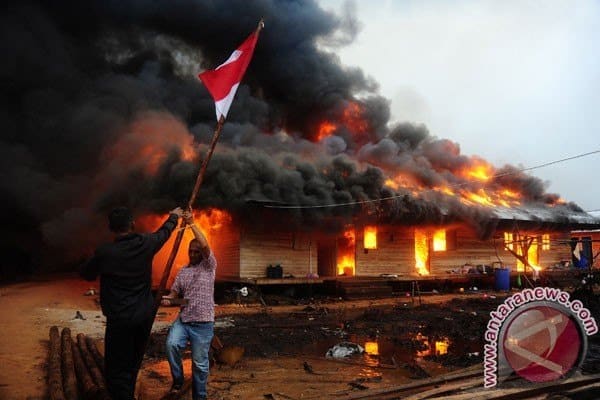
The Indonesian state officially recognises just six religions – it has yet to provide any space for new religious movements like Gafatar. Photo by Jessica Helena Wuysang for Antara.
Rubble and charred timber are all that remain of the settlement of former members of the Fajar Nusantara Movement, or Gafatar, in Mempawah, West Kalimantan. Two weeks ago, a mob descended on the community, torching their houses and forcing them to flee. The government is now returning the 1,000-plus displaced people to their home villages in Java. The attack is just the latest manifestation of violence against minorities in the reform era.
Gafatar is a new “religious” movement. The word “religious” is, in theory, a broad term and can have a different meaning for different people – it is not defined by any one tradition, group, or sect. “Religious” can of course refer to all traditions that contain spiritual elements, whether mainstream religions with millions of adherents across the globe, or local indigenous religions, followed by only a small group of people in a specific area.
The problem is that the Indonesian state formally recognises just six religions (Islam, Protestantism, Catholicism, Hinduism, Buddhism and Confucianism). It has yet to provide any space for new religious movements like Gafatar, which aim to offer teaching, concepts, or rules to provide solutions not found in the formal religions.
As most of the Indonesian population is Muslim, most religious issues are understood from the perspective of Islam, or at least the Abrahamic tradition. The government often appears apprehensive or inept when attempting to deal with new religious movements that do not follow the established traditions of the main global religions.
As a country rich in religious and spiritual traditions, religious movements have always played an important part in national life. In Indonesian history, almost all political movements have contained a significant religious element. In the colonial era, for example, Sarekat Islam was crucial for the nascent independence movement. Years later, in the New Order period, major Muslim social organisations Nahdlatul Ulama and Muhammadiyah played a critical role in advocating for democratic reforms. Political parties continue to align themselves with religion in an attempt to attract votes.
Although Gafatar was not well known until recently, its genesis can be traced back to the early reform era and the Al-Qiyadah Al-Islamiyah movement.
Al-Qiyadah Al-Islamiyah was led by Ahmad Moshaddeq and was said to incorporate elements of Islam, Christianity and Judaism. The Indonesian Council of Ulama (MUI) published a religious edict (fatwa) declaring it to be a deviant sect in 2007 and the following year Ahmad Moshaddeq was sentenced to four years in prison for blasphemy.
Since then, the movement has continued to evolve, and has been called the Milah Abraham movement, and more recently, Gafatar. Leaders of Gafatar say that the movement was disbanded in August 2015, and former members reportedly moved to West Kalimantan a few months ago to establish a food security program.
Gafatar is far from the only new religious movement to emerge in the reform era. A number of new religious movements materialised in the turbulent period following the transition to democracy. The fall of Soeharto in 1998, and the political, economic and social turmoil that accompanied it, provided favourable conditions for the growth of new religious movements. In Jakarta alone, we have seen movements established by HMA Bijak Bestari, Lia Eden, Agus Imam Solihin, and many others. In Cirebon, there was Imam Ahmad Tantowi; in East Java, Ahmad Naf’an (Gus A’an); in Central Java, Raden Suminto Joyo Kusumo; and in West Nusa Tenggara, Amaq Bakri. Indonesia, it seems, is fertile ground for the birth of these new “prophets”, all of whom claim to have received divine revelation through a variety of methods.
During the New Order period, new religious movements such as these were grouped together under the broad terms aliran kepercayaan or aliran kebatinan (“faith-based movements”). Under Soeharto, these groups survived, although their followers lived with fear and marginalisation, facing repression by the government and prejudice from society. Many of these aliran were recognised not as religions but as mere sects, and put under the umbrella of one of five official religions acknowledged by the government at that time.
Ironically, these groups have found it even harder to exist following the transition to democracy in 1998. Many of the leaders of these new religious movements have been charged with blasphemy under Law No. 1 PNPS/1965 (the Blasphemy Law), which inserted an article on blasphemy into the Criminal Code. There has, in fact, been a significant increase in the use of the Blasphemy Law in the democratic era. While it was only used a handful of times in the New Order period, more than 120 people have been convicted for blasphemy since the fall of Soeharto.
In addition to facing criminal charges, some new religious movements have been attacked by hard-line Islamic groups. The reform period has seen a rise in the number and influence of violent Islamist groups seeking to uphold orthodoxy and crack down on behaviour that they consider immoral. They often justify their violent and intolerant actions by referring to MUI fatwa that brand these new religious movements as deviant or heretic.
Culture and traditions across this archipelagic nation are complex, plural and dynamic. As long as Indonesians remain a pious people oriented toward religion, new religious movements that seek to distinguish themselves from the mainstream will continue to emerge. It is a natural consequence of having such a diverse society. Both the government and Indonesian citizens need to accept this fact. The birth and expansion of new religious movements cannot be stopped with repression or marginalisation, including by prosecution through the legal system. Suppressing one movement will only lead to others emerging to take its place.
As a country that claims to live by the motto Bhinneka Tunggal Ika (Unity in Diversity), it is time for Indonesia to reassess what it means by diversity. During the New Order period, bhinneka was understood as providing room for different faiths. But the Soeharto government failed to acknowledge the massive diversity of religious traditions in Indonesia. Tolerance was understood as tolerance for the official religions. Faith-based movements had no legal protection.
There are more than 600 religious traditions in Indonesia – not just six. It is the responsibility of the current generation to understand and protect this diversity, including protecting new religious movements. The meaning of bhinneka should be revisited and broadened to encompass all religious traditions — be they official or new religious movements.
There is nothing to be gained from judging or stigmatising Gafatar just because its beliefs diverge from the mainstream. Gafatar and its followers must be treated with humanity, just as any other Indonesian would expect to be treated. All citizens are equal before the law, whether they are from a new religious movement or one of the six formal religions.
A shorter version of this piece was published in Jawa Pos as “Ketika Toleransi Tak Lagi Cukup” on 28 January 2016.


